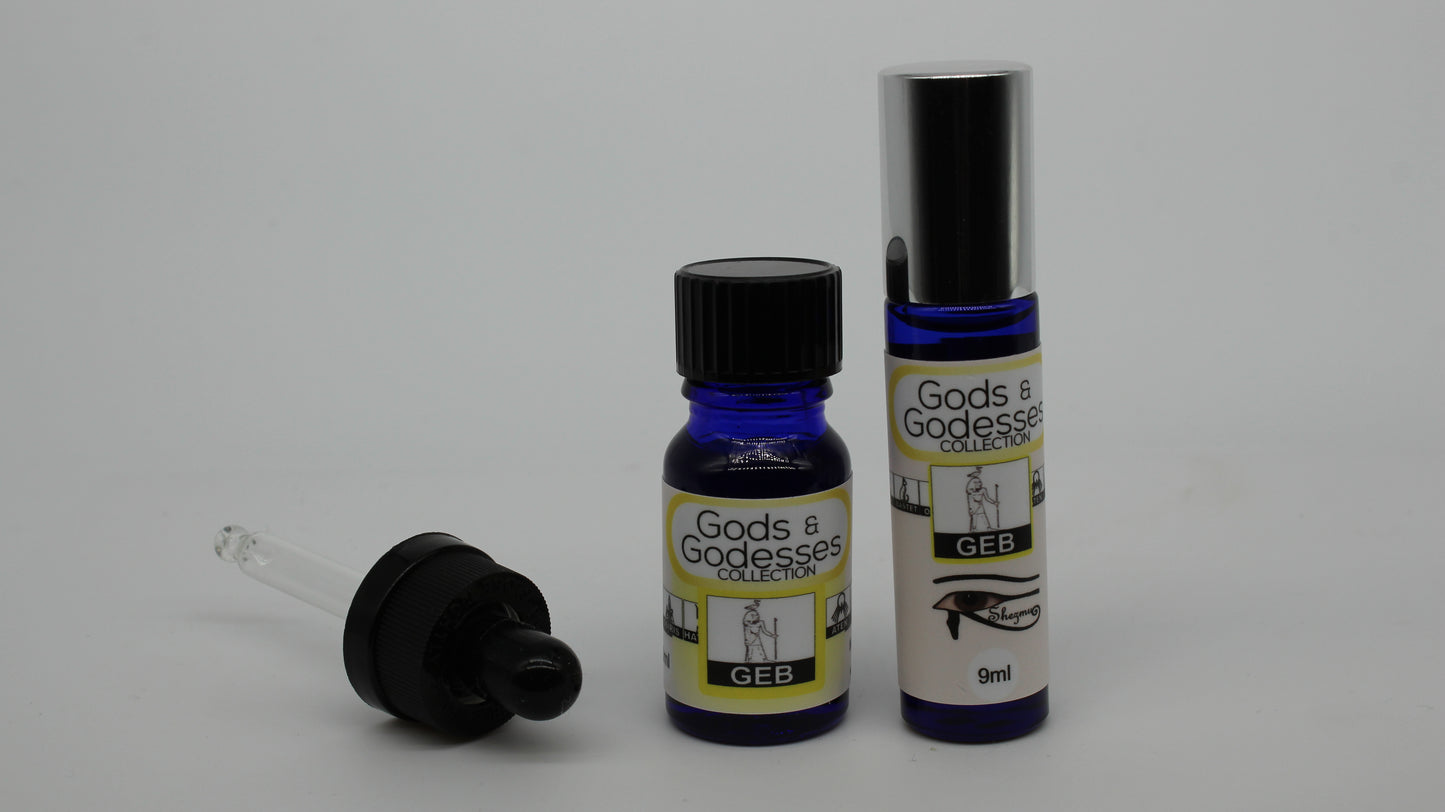My Egypt
Shezmu GEB Egyptian Essences Oils 10ml dropper, 9ml roller. Imported from Egypt
Shezmu GEB Egyptian Essences Oils 10ml dropper, 9ml roller. Imported from Egypt
Couldn't load pickup availability
Price includes Shipping and Insurance Australia Wide.
Egyptian Oils Shezmu Egyptian Geb Essence Oil in 10 ml dropper/9ml roller
This is one of our Gods and Goddesses Collection
Pure oils imported from Egypt. We store and use dark Amber and Cobalt Blue bottles.
GEB
Geb was the Egyptian god of the earth and a mythological member of the Ennead of Heliopolis. He could also be considered a father of snakes. It was believed in ancient Egypt that Geb's laughter created earthquakes[1] and that he allowed crops to grow.
This oil is to help you to connect with the god Geb.
SCENT:
A masculine scent with a refreshing but refreshing scent of refreshing, bitter citrus and herbal scents. The slight sweetness reminds me of the connection with the earth.
Fragrance system: Citrus Woody
Ancient Egyptians were masters of the holistic and believed that beauty, magic, and medicine were inseparable to provide holistic therapy in such a manner that the body cannot be separated from the mind, soul, or spirit.
Ancient Egyptians were masters of the holistic and believed that beauty, magic, and medicine were inseparable.
It is believed that ancient Egyptians were the first in the world to invent extraction of flower essences, and they are credited as that some of the first perfumers in history. Egyptians were the first civilization to incorporate perfume into their culture.
Egyptian Essences has a unique feature; it strengthens with body heat. As more and more of your body heat is released it becomes stronger, it, therefore, is a slow release perfume, making it long lasting when you apply it.
Everything Egyptian is at My Egypt. "Share the Passion"
We have a bricks and mortar store at Mudgeeraba Qld.
We import direct from our friends in Egypt to get the best Quality pieces. There is no slave or child labor with any of our goods. We support small Family Businesses which has a Flow on effect to the small families. This item is a great gift for yourself, someone who loves Egypt or is a pyramididot or just loves everything Egyptian.
History of Perfume
The word perfume is derived from the Latin perfume, meaning "through smoke." The art of perfumery was known to the ancient Egyptians. References to perfumery materials and even perfume formulas are found in the Ancient Egyptian Burial sites, Tombs and in the Bible. The burning of incense in religious rites of ancient China, Palestine, and Egypt led gradually to the personal use of perfume known as attar's, widespread in ancient Greece and Rome. During the Middle Ages Crusaders brought knowledge of perfumery to Europe from the East. After 1500 Paris was the major center of perfume-making.
Today Egypt is still a major trading center for the perfume industry. We have teamed up with the best perfume trading houses in Egypt.
What's the difference between perfume oils and perfume?
Please do not confuse these perfume oils with cologne or essential oils. Pure perfume, essences oils are far more sophisticated than perfume with fillers. Never offensive or overpowering, long lasting and balanced.We at My Egypt are honored to be able to offer you the best in fragrance - drop for drop we offer a superior product. Try us - we think you'll agree.
We will ship overseas. Please email us for shipping costs
Made in Egypt. Product of Egypt.
Notes[edit]
- ^ "Geb". Retrieved 6 October 2014.
- ^ Wallis Budge, E. A. (1904). The Gods of the Egyptians: Studies in Egyptian Mythology. Kessinger publishing. ISBN 978-0766129863. Retrieved 6 October 2014.
- ^ Meskell, Lynn Archaeologies of social life: age, class et cetera in ancient Egypt Wiley Blackwell (20 Oct 1999) ISBN 978-0-631-21299-7 p.103
- ^ Van Dijk, Jacobus. "Myth and Mythmaking in Ancient Egypt" (PDF). Jacobusvandijk. Retrieved 26 May 2017.
- ^ Dunand, Francoise (2004). Gods and Men in Egypt 3000 BCE to 395 CE. Armand Colin. p. 345. ISBN 9780801488535.
- ^ Jump up to:a b Wilkinson, Richard H. (2003). The Complete Gods and Goddesses of Ancient Egypt. Thames and Hudson. p. 105–106. ISBN 9780500051207.
- ^ Pinch, Geraldine (2002). Handbook of Egyptian Mythology. Santa Barbara: ABC-CLIO. pp. 76, 77, 78. ISBN 9781576072424.
- ^ C. Wolterman, "On the Names of Birds and Hieroglyphic Sign-List G 22, G 35 and H 3" in: "Jaarbericht van het Vooraziatisch-Egyptisch genootschap Ex Oriente Lux" no. 32 (1991–1992)(Leiden, 1993), p. 122, note 8
- ^ Jump up to:a b c text: Drs. Carles Wolterman, Amstelveen, Holland
- ^ Kockelmann, Holger (2017). Der Herr der Seen, Sümpfe und Flußläufe. Untersuchungen zum Gott Sobek und den ägyptischen Krokodilgötter-Kulten von den Anfängen bis zur Römerzeit. Vol. 1. Wiesbaden: Harrassowitz. pp. 81–88. ISBN 978-3-447-10810-2.
- ^ Rondot, Vincent (2013). Derniers visages des dieux dʼÉgypte. Iconographies, panthéons et cultes dans le Fayoum hellénisé des IIe–IIIe siècles de notre ère. Paris: Presses de lʼuniversité Paris-Sorbonne; Éditions du Louvre. pp. 75–80, 122–127, 241–246.
- ^ Sippel, Benjamin (2020). Gottesdiener und Kamelzüchter: Das Alltags- und Sozialleben der Sobek-Priester im kaiserzeitlichen Fayum. Wiesbaden: Harrassowitz. pp. 73–78. ISBN 978-3-447-11485-1.

-
Shipping
Share the details of your shipping policy.
-
Returns
Share the details of your return policy.
Image with text
Pair text with an image
Pair text with an image to focus on your chosen product, collection, or artist. Add details on availability, style, or even provide a review.
Image with text
Pair text with an image to provide extra information about your brand or collections.
